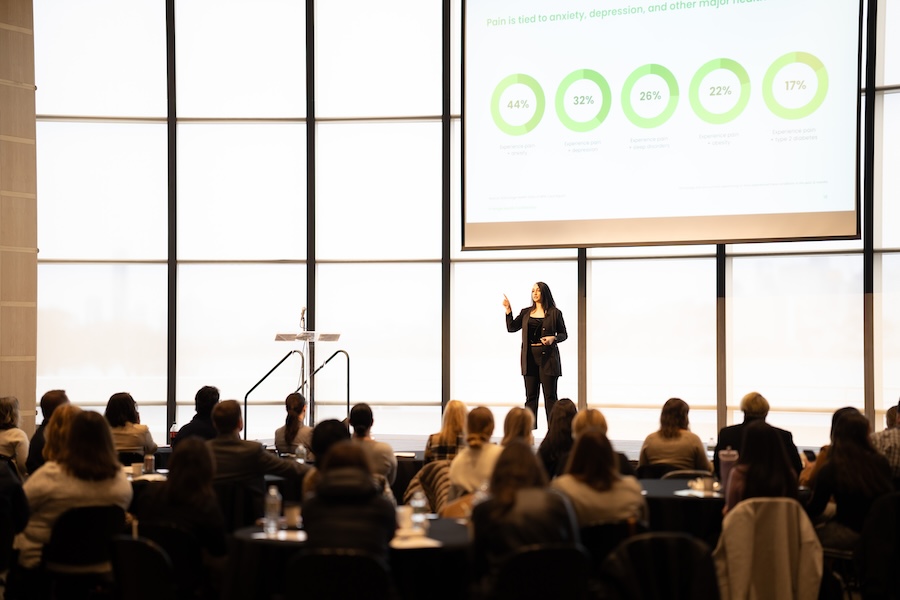Moving Beyond Pain: A New Approach for a Country in Crisis


One of Dr. Bijal Toprani’s physical therapy patients was a competitive ice hockey player, even through college. “He was even sticking with it into adulthood, playing in the rec league at New York’s Chelsea Piers,” she said in a thought leadership spotlight during From Day One’s Boston half-day benefits conference. But one day, this patient hurt his back at the gym. The pain became chronic and he needed a solution.
“That had a cascading effect on his mental health,” said Dr. Toprani, doctor of physical therapy at Hinge Health, an online clinic for muscle and joint care. The patient was previously playing hockey every Monday among his friends, and skipping that weekly commitment led to isolation. A situation like this can lead to underperformance in work, too. “The patient said they might consider leaving their job because of pain,” she said.
To better understand the issue it’s important to understand what chronic pain is. A shoulder strain or a broken bone can be resolved within a reasonable time frame if treated appropriately. “When we think of chronic pain, it’s pain that exists from months to years,” said Dr. Toprani.
The people experiencing this pain can become desperate for relief, often turning to opioids. Currently, data shows that one in five people suffering from chronic pain gets an opioid prescription, she says. “Unfortunately, it’s easier, more convenient, and cheaper than finding a physical therapist.”
Pain does not exist in a silo, and creates a series of comorbidities. Hinge Health’s 2024 State of Care report indicates that 44% of sufferers are also affected by anxiety, 32% by depression, 26% by a sleep disorder, 22% by obesity. It makes sense: thinking of pain does cause anxiety, it prevents you from falling asleep, and it hinders exercise, which, in turn, can cause weight gain. The costs accrued for musculoskeletal system (MSK) problems amounts to around $635 billion dollars, and it’s estimated that 48% of people don’t do anything about it, other than getting a cortisone shot.

Physical therapy is considered the best first-line treatment, but remains underutilized. “Another barrier is the lack of understanding of benefits, and that’s specific to MSK care,” said Dr. Toprani. “You don’t know what’s in-network or what’s out-of-network.” Many people in pain believe that traditional PT is too expensive to pursue, and nearly 1/3 find it challenging to access physical therapists. For those who do see a physical therapist, many end up discontinuing their course of care for similar reasons.
Physical therapy sits at the intersection of medical care and lifestyle change, and Hinge Health positions itself as a digital clinic specializing in joint and muscle pain, combining technology and traditional physical-therapy care. Chronic pain is more complicated and complex than “just doing exercises,” said Dr. Toprani. Only a small percentage of respondents used digital PT (10%) or a hybrid of digital and in-person PT (17%) in the past 12 months, but they are more likely to have a positive outlook on their pain compared to people who used traditional PT (72%).
A digital interface solves another barrier: “48% of people say a digital PT program would make it easier to follow their care plan, and 43% say they need PT care that has a digital component,” said Dr. Toprani, citing Hinge Health’s 2024 report. The digital program is accessible outside of regular work hours, and offers a demonstration of exercises that encourages practice between sessions with a clinician.
A MSK program with a digital component has other benefits: those who use Hinge Health report 68% average reduction in pain per participant, says Dr. Toprani, ultimately supporting a happier and healthier patient.
Editor’s note: From Day One thanks our partner, Hinge Health, for sponsoring this thought leadership spotlight.
Angelica Frey is a writer and a translator based in Boston and Milan.
The From Day One Newsletter is a monthly roundup of articles, features, and editorials on innovative ways for companies to forge stronger relationships with their employees, customers, and communities.